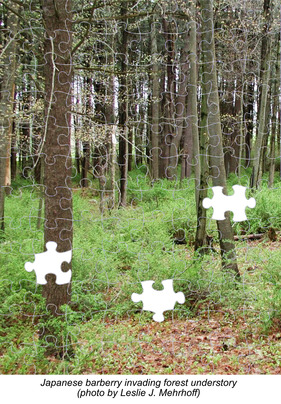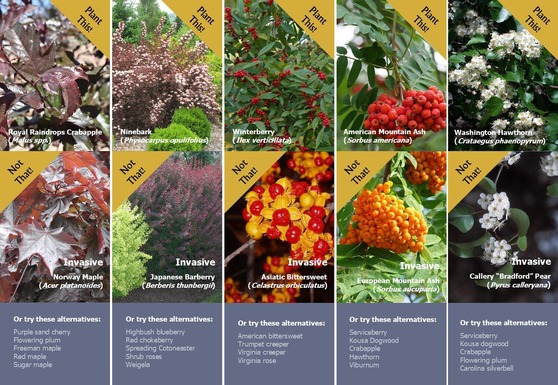|
Correction: Forgo planting a ?Crimson King? Norway maple. Instead, appreciate the brilliant fall color of an ?Autumn Blaze? Freeman?s maple or the colorful purpleleaf sand cherry. Not a European copper beech as previously stated. We apologize for the inconvenience.
NISAW Day 3: Invasive Plants
... and Maine's Ecological Puzzle

What do plants like ?Crimson King? Norway maple, burning bush, and Japanese barberry have in common? They are long-standing favorites in urban and suburban landscapes; they grow quickly and provide beautiful red or purple foliage all year or in the fall. Those are their positive attributes. Unfortunately, they all have become invaders in our forests, farms, and natural areas. Each is now classified as ?invasive.?
Invasive plants are like pieces that don?t fit Maine?s ecological puzzle. By crowding out native plants, they leave holes in the food web and can exclude other pieces of the puzzle, creating even more significant gaps. These gaps in the food web can cascade and eliminate the food source for other species like caterpillars, an essential food for baby birds. Maine?s chickadees depend upon caterpillars to provide their nestlings with protein to grow and develop into adulthood.
|
Yes, all this can happen just because we decide to plant an invasive species into our landscape.
In some of Maine?s forested areas, the forest floor is covered with plants like Japanese barberry and its many needle-like spines. Although white-tailed deer seem to eat almost any plant, they do not like Japanese barberry. The barberries create a food desert for deer and open large holes in the ecological puzzle.
So what is a gardener to do?
Many alternative plants provide equal or better aesthetic characteristics in our landscapes. Some are Maine natives that fit perfectly in our ecological puzzle. Others are non-natives that stay put and don?t wreak havoc on the ecosystem like ?invasive? plants can.
- Forgo planting a ?Crimson King? Norway maple. Instead, appreciate the brilliant fall color of an ?Autumn Blaze? Freeman?s maple or the colorful purpleleaf sand cherry; or
- Enjoy the fruitful antioxidant rewards of a highbush blueberry or a red chokeberry in place of the food desert created by Japanese barberry; or
- Make wreaths from winterberry instead of the tree-choking Asiatic bittersweet, whose berries can be picked off wreaths and planted elsewhere by birds and mice.
 Invasive plant bookmarks developed by DACF Horticulture Program
Planting well-behaved non-native and native plants helps keep Maine?s ecological puzzle together. This complete picture is essential to the survival of many species we love and depend upon. Help keep the puzzle whole and choose to exclude invasive plants from your garden.
As of January 1, 2024, Maine prohibited the sale of 30 additional invasive terrestrial plants (63 total) and required signs or tags placed at points of sale for Rosa rugosa. For the complete list of regulated plants and more information on great alternatives, go to maine.gov/hort or scan the QR code below.
|
